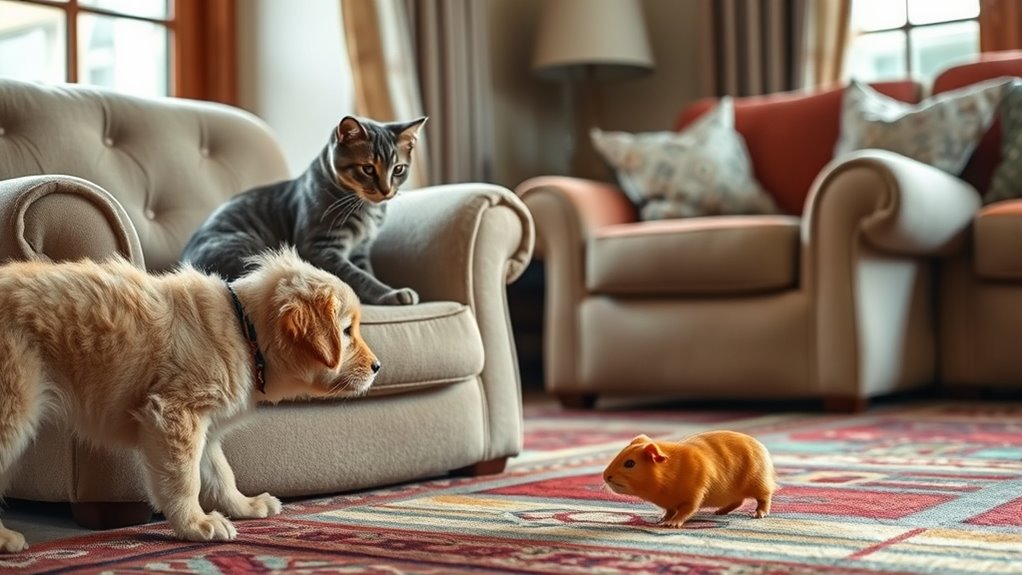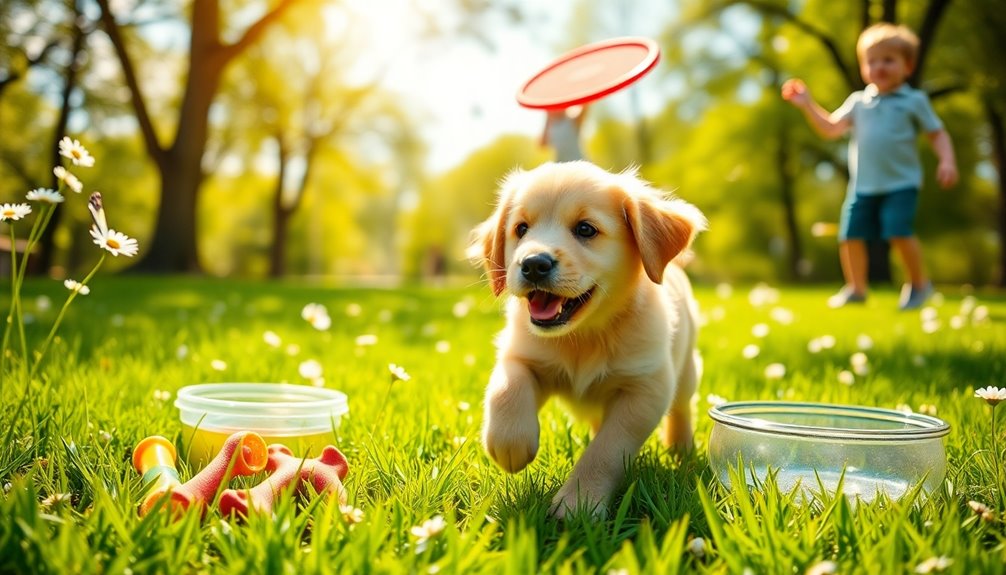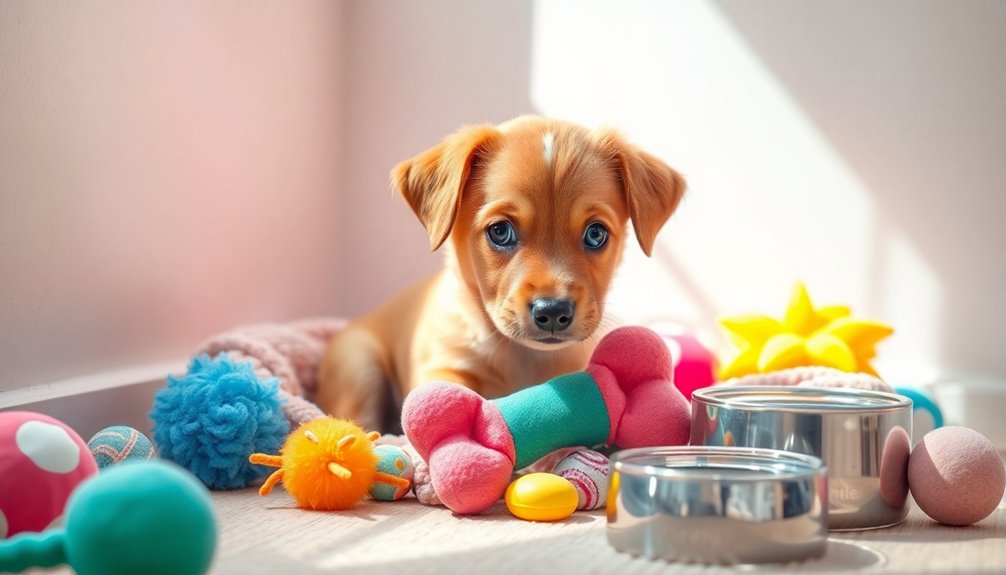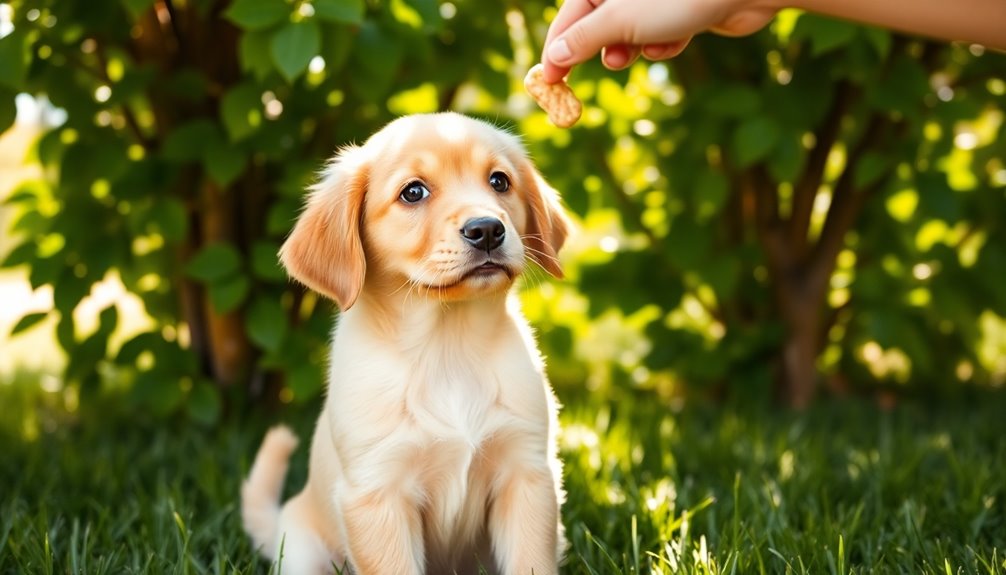When introducing your puppy to other pets like cats, dogs, or small animals, start in neutral areas with controlled, short interactions. Keep everyone on a leash or behind barriers, watch their body language for signs of comfort or stress, and use positive reinforcement like treats. Be patient, respond to signals promptly, and give pets time to adapt at their own pace. To learn detailed tips for smooth introductions, keep exploring these strategies.
Key Takeaways
- Use neutral spaces and controlled environments for initial introductions to reduce stress.
- Observe pet behavior cues such as tail wagging, relaxed posture, or signs of fear and aggression.
- Keep pets on a leash or behind barriers during initial meetings to ensure safety.
- Gradually increase interaction time, rewarding positive behavior with treats and praise.
- Be patient, responding promptly to cues, and separate pets if signs of tension or aggression appear.
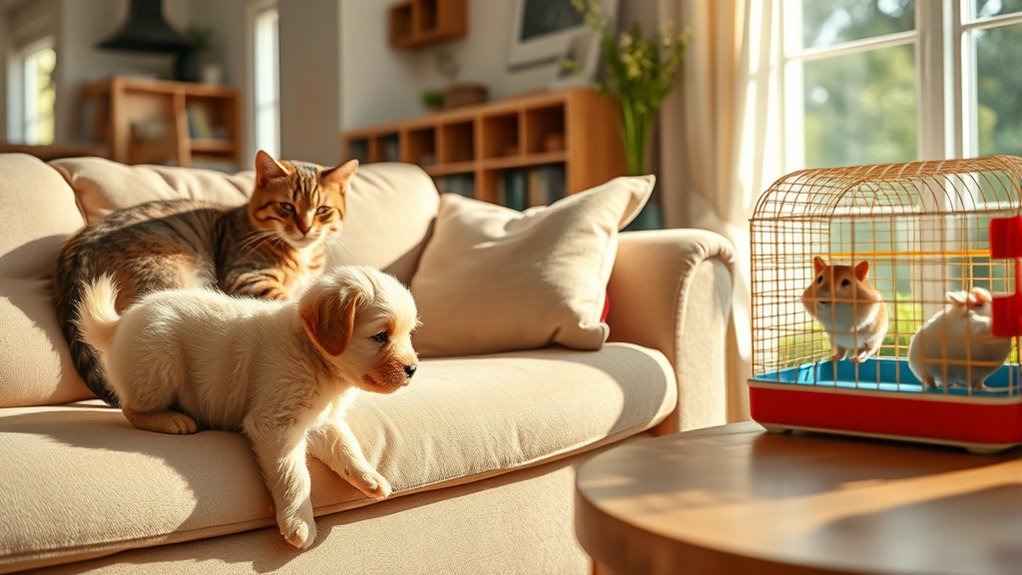
Introducing your puppy to other pets can be a smooth process if you approach it carefully and patiently. The key to successful introductions is early puppy socialization, which helps your pup learn how to interact appropriately with different animals. As you introduce your puppy to cats, dogs, or small animals, pay close attention to pet behavior cues. These cues reveal how your puppy is feeling and whether the interaction is going well or needs adjustment. Recognizing signs of stress or aggression early allows you to intervene before the situation escalates.
Start by setting up controlled meetings in neutral spaces. For example, if introducing your puppy to a resident cat, keep both animals on a leash or behind a baby gate initially. This setup allows you to monitor their behavior without risking injury. Watch your puppy for pet behavior cues, such as tail wagging, relaxed posture, or sniffing, which generally indicate curiosity and comfort. Conversely, growling, raised hackles, or flattened ears signal discomfort or fear. If your puppy exhibits signs of stress, calmly redirect their attention and give both animals a break before trying again.
Start with neutral spaces, keep pets on a leash, and watch for cues like wagging tails or growling.
When it comes to introducing your puppy to other dogs, it’s best to start with short, supervised interactions in a secure area. Keep both dogs on a leash and allow them to approach at their own pace. Observe their body language closely; a wagging tail and relaxed body are positive signs, while stiff posture or raised lips suggest tension. If either pet shows signs of aggression or fear, separate them immediately and try again later. Consistent positive reinforcement, like treats and praise, reinforces good pet behavior cues and helps your puppy associate new encounters with pleasant experiences.
Introducing your puppy to small animals such as hamsters, guinea pigs, or rabbits requires extra caution. These animals are delicate and easily frightened, so initial introductions should happen in a secure enclosure where your puppy can see and sniff but not reach them. Watch for pet behavior cues like sniffing gently or sitting calmly, which show curiosity without aggression. If your puppy becomes overly excited or starts to chase, redirect their attention with commands or toys. Over time, gradual exposure paired with positive reinforcement can help your puppy learn to coexist peacefully with small animals.
Throughout all these introductions, patience is essential. Every pet is different, and some may take longer to adjust than others. Consistently observe pet behavior cues and respond appropriately, creating a positive environment for everyone. Additionally, adopting a holistic SEO approach by integrating content that emphasizes safety and understanding can foster better relationships among your animals. With careful planning and understanding of your pets’ signals, you’ll help foster safe, happy relationships among your animals.
Frequently Asked Questions
How Can I Tell if My Puppy Is Jealous of Other Pets?
If your puppy is jealous of other pets, you’ll notice jealousy cues like whining, pushing you for attention, or sulking when they’re near your pet. They might also try to get between you and the other animal or become overly clingy. Watch for these signs, and make sure you give your puppy plenty of pet attention to reassure them. Consistent positive reinforcement helps reduce jealousy and encourages good behavior around your other pets.
What Are Signs of Stress During Pet Introductions?
During pet introductions, stress signs include tense body language cues like stiff posture, raised hackles, or pinned ears. You might notice excessive yawning, lip licking, or avoiding eye contact. Environmental triggers, such as loud noises or sudden movements, can heighten stress. Watch for these cues closely, and keep the environment calm and controlled to help your puppy feel safe and reduce anxiety during the introduction process.
How Long Should Introductions Take for a Positive Bond?
Ever wonder how long it takes for a positive bond to form? Generally, the pet introduction timeline varies, but you should give it a few weeks of consistent, supervised interactions. Puppy socialization is vital during this period, so be patient and gradual. Rushing the process can cause setbacks. Usually, with gentle, positive experiences, your pets will start to accept each other in 1 to 2 weeks.
Can Introducing Multiple Pets at Once Cause Issues?
Introducing multiple pets at once can cause issues, especially if you’re doing simultaneous pet introductions. It can overwhelm your puppy and existing pets, leading to stress or aggression. To avoid this, introduce them gradually, one at a time, and supervise their interactions. This way, you give each pet a chance to adjust, helping foster positive bonds and reducing potential conflicts during multi pet introductions.
How Do I Handle Aggressive Behavior From My Puppy or Pets?
When your puppy or pets act aggressively, don’t ignore it—tackle it head-on. You need to reinforce puppy obedience and employ pet training techniques consistently. Redirect their attention, use positive reinforcement, and set clear boundaries. Remember, patience is your best tool; with steady guidance, you can turn aggressive moments into opportunities for learning and growth. Staying calm and firm helps your pets feel secure, reducing future aggression.
Conclusion
Now that you’ve navigated the nuances of introducing your puppy to other pets, remember patience and persistence are key. With careful planning, positive reinforcement, and plenty of praise, you’ll build bonds that last. Keep calm, stay consistent, and celebrate small successes. Soon, your new furry family will flourish, forging friendships filled with fun and familiarity. Together, you’ll create a cohesive, caring community where every pet feels safe, secure, and loved.

